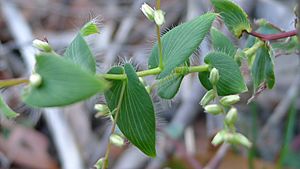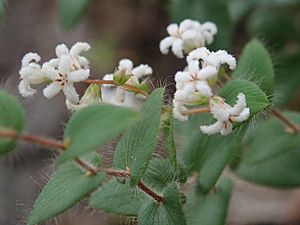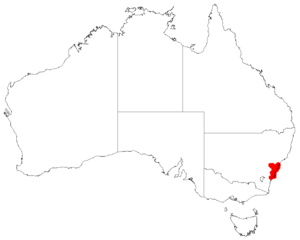Beard-heath facts for kids
Quick facts for kids Beard-heath |
|
|---|---|
 |
|
 |
|
| Scientific classification | |
| Genus: |
Leucopogon
|
| Species: |
amplexicaulis
|
 |
|
| Occurrence data from AVH | |
The Beard-heath (scientific name: Leucopogon amplexicaulis) is a type of shrub. You can find this plant growing in southeastern Australia. It's known for its unique heart-shaped leaves and small white flowers.
Contents
About the Beard-heath Plant
What's in a Name?
An English botanist named Edward Rudge first described this plant in 1807. He called it Styphelia amplexicaulis. Later, in 1810, a Scottish botanist named Robert Brown gave it its current name, Leucopogon amplexicaulis. The word "amplexicaulis" comes from Latin. It means "stem-clasping," which describes how the leaves wrap around the stem.
How Does It Look?
The Beard-heath is a slender plant. It can grow up to 0.9 meters (about 3 feet) tall. Sometimes, it even scrambles along the ground. Its small branches have fine hairs. The leaves are special because they are shaped like a heart. They are about 9.5 to 34 millimeters long and 4.5 to 20 millimeters wide. These leaves famously surround the stem at their base.
Flowers and Fruit
You can see the white flowers of the Beard-heath from July to November. They are most common in August and September. These are small, tube-like flowers. Three to twelve of them grow along stalks that can be up to 3.7 centimeters long. After the flowers, the plant grows fleshy fruits. These fruits are called drupes. They become ripe from September to December.
Where Does Beard-heath Grow?
Its Natural Home
The Beard-heath grows in New South Wales, Australia. You can find it from the Sydney Basin all the way south to Shoalhaven. It prefers to grow in sandy soils. It lives in a type of forest called sclerophyll forest. These forests have tough, dry leaves.
Favorite Spots
This plant likes sheltered places. You often see it on sandstone rocks and flat areas. It especially likes spots near natural water seeps. In the Sydney area, it grows alongside other plants. These include trees like Sydney peppermint (Eucalyptus piperita). Other tree friends are red bloodwood (Corymbia gummifera) and smooth-barked apple (Angophora costata). It also grows near shrubs like heath banksia (Banksia ericifolia), coral fern (Gleichenia dicarpa), and dog rose (Bauera rubioides).
Life and Growth of Beard-heath
Living Through Time
Beard-heath plants can live for twenty to thirty years. They become more common in areas that have not had bushfires for a long time. This is because bushfires kill the Beard-heath plants.
How It Reproduces
When a fire happens, the Beard-heath dies. But it can grow back from its seeds. Scientists think that ants might help spread these seeds around. This process is called myrmecochory.
Growing Beard-heath at Home
It can be a bit tricky to grow plants from the Leucopogon family. This is because their seeds or cuttings can be hard to start. If you want to grow Beard-heath in your garden, it needs certain conditions. It likes soil that drains water well. It also needs plenty of moisture and some dappled shade. This means it should get some sunlight but also some shade. Large stones can help keep the roots cool.
Uses and Benefits
For Gardens and Learning
Beard-heath is mostly used for its beauty. People plant it in home gardens and public parks. It's also displayed in botanical gardens. This helps people learn about different plants. Its pretty look means it can even be used to make bouquets.
Helping the Environment
Like many plants, Beard-heath has good effects on the environment. Its roots help hold the soil together. This stops soil from washing away, which is called soil erosion. The plant also has chlorophyll in its leaves. This helps it do photosynthesis. During photosynthesis, the plant takes in carbon dioxide. Then, it releases oxygen. This process helps fight global warming by cleaning the air.
Images for kids


